Compartir
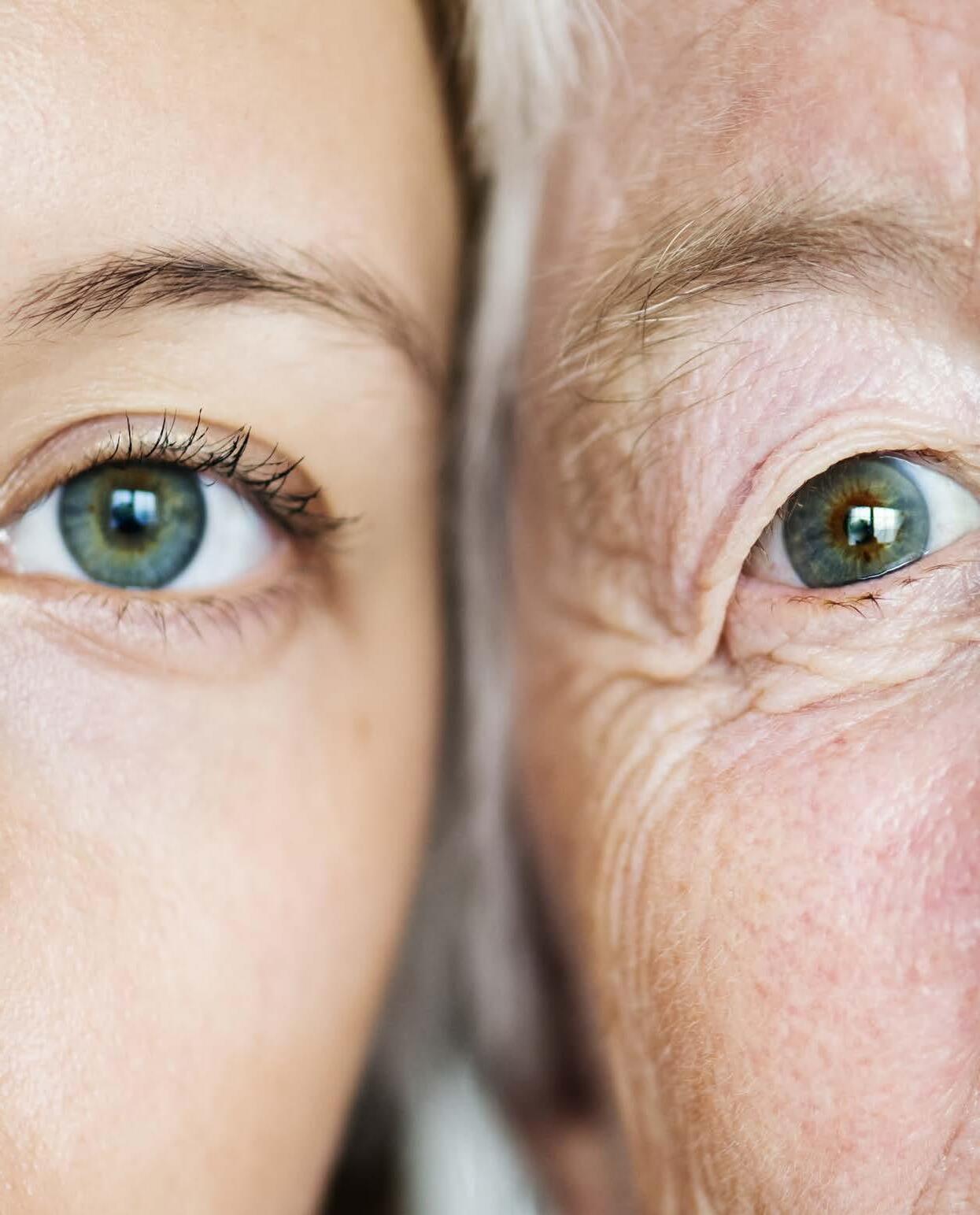
HOW WILL THE NEW GENERATIONS AGE?
Tamara Pazos and Carlos López-Otin reflect on the great unknown element of healthcare



Tamara Pazos and Carlos López-Otin reflect on the great unknown element of healthcare

Compartir
Healthcare cooperativism magazine www.compartir.coop compartir@fundacionespriu.coop
Editorial board:
Dr. Ignacio Orce, chairman of the Fundacion Espriu and of Assistencia Sanitaria
Dr. Enrique de Porres, CEO of ASISA-Lavinia
Dr. Oriol Gras sponsor of the Fundacion Espriu
Dr. Carlos Zarco, General Manager and sponsor of the Fundacion Espriu
Publication: Factoria Prisma Diagonal 662-664
08034- Barcelona
Tel. 639 213 710 www.factoriaprisma.com
Director of Factoria Prisma: Angi Gonzalez Vives Coordination: Laura Martos
Design: Xavi Menéndez
Printer: Centro Gráfico Ganboa SL Legal Deposit: B-46099-2003
ISSN: 2488-6394
ISSN (Internet): 2696-3833
Fundación Espriu
Av. de Josep Tarradellas, 123-127 4.ª planta 08029 Barcelona
Juan Ignacio Luca de Tena, 12, 3.ª 28027 Madrid
FIN: G-59117887
Tel.: 934 954 490
fundacionespriu@fundacionespriu.coop www.fundacionespriu.coop
Established in 1989, the Fundacion Espriu integrates the bodies that practice the cooperative healthcare model created by Dr. Josep Espriu: Augtogestió Sanitària, SCIAS, Lavinia and ASISA, which form the Assistència Group and the ASISA Group.
Two international reports show the mental health trends for the next few years.
Chronic pain goes beyond just physical discomfort. How can it be dealt with and what healthy habits can help to cope with it?

Compared to complete rest, active recovery offers physiological benefits that shorten recovery times.
Special seminars, new equipment and the opening of centres were the leading elements for cooperatives during the summer period.
What type of old age can the new generations expect with the scientific advances and the possibility of cultivating healthy habits?


The increase in life expectancy is one of the great achievements of our society. Scientific and medical advances have allowed us to extend our years of existence, but with this conquest an unavoidable reflection arises: what will our lives be like during these added years? Beyond the amount, the true question that concerns us is that of evaluating the quality of life that we can expect.
This autumn issue opens with an in-depth report on this challenge, the paradigm of future old age. A journey that invites us to think about the role that factors such as prevention, healthy habits and the socio-economic context will play in the way in which the new generations will get older. Although we cannot anticipate all the determining factors that will surround them, it is in the hands of these new generations to cultivate routines today that will strengthen both the body and the mind in order to be able to enjoy a longer, active life span. To talk about it, we have brought in two internationally renowned experts: the doctor in biochemistry, Carlos López-Otín and the scientific journalist, Tamara Pazos.
On the health pages you will also find practical content to face up to getting back to the routine after the summer with some preventive tools and useful advice to maintain our well-being, day by day. And lastly, we close this issue with leisure proposals that include day trips to take advantage of the last weeks of longer days before the clocks go back, as well as an approach to cultural phenomena that awaken curiosity and connect generations. Have you heard of the term hallyu? We invite you to find out all about it in our pages.
I hope that this issue accompanies you in the return to your routine with objective, proximate information that inspires you to look after your health today (as well as, of course, your future health).
We explore the five most attractive forests on the Spanish mainland to welcome the autumn in amongst the red, ochre and golden fall colours.
South Korea has become a benchmark for pop culture and its growth is showing no signs of slowing down over the next few years.
Mental health continues to be one of the great challenges for public healthcare on a global scale. According to the latest data from the World Health Organisation (WHO), over one billion people suffer from mental disorders, mainly anxiety and depression, which in addition to the human impact, generate large scale economic costs.
The WHO insists that the transformation of the mental health services is an urgent priority and to do this, it has used the figures to back this claim, included in two reports that analyse the global situation.
The World Mental Health Today report shows that suicide continues to be one of the main causes of death amongst young people, with around 727,000 deaths recorded in 2021, and the current trend will only allow its incidence to be reduced by 12% from here to 2030, far from the target set out in the Sustainable Development Goals (33%). It also concludes

The kiwi is the first
The green kiwi has become the first fresh fruit with healthy properties recognised by the European Commission, a milestone in the food sector. Over the past five years, only three health declarations had been passed, which underscores the difficulty of a process that demands solid, exhaustive scientific proof.

The approved declaration indicates that the consumption of 200 grammes daily of fresh green kiwi pulp contributes to the normal functioning of the bowel, as it increases the frequency of the stools. This authorisation will allow the fruit to be advertised and labelled with this specific benefit.
The digestive effect of the kiwi is mainly attributed to its high content in both soluble and insoluble fibre, which improves the bowel movements, preventing constipation and helps to maintain a healthy colon. Added to this are other nutritional benefits such as its vitamin C content, essential for strengthening the immune system and for producing collagen.
Diabetes is a chronic disease characterised by the organism’s incapacity to produce or effectively use insulin, which causes an increase of glucose in the blood and serious complications in the long-term. Its impact worldwide went from 108 million in 1980 to over 830 million in 2022. In Latin America, it now forms the fourth cause of death and globally, it represents an important risk factor for public health, linked to blindness, kidney failure, cardiovascular diseases and amputations.
World Diabetes Day, introduced by the WHO and the International Diabetes Federation and held every 14th of November, seeks to make people aware of this growing problem. The slogan for the 2024-2026 period, “Diabetes and well-being,” underscores that care must not only concentrate on controlling the blood sugar level, but also on the comprehensive well-being of those who live with the disease.
Quotes that inspire
“Healthisnoteverything,butwithouthealth,everythingis nothing.”
Arthur Schopenhauer, philosopher
The current trend will only allow the incidence to be reduced by 12% from here to 2030, a long way from the Sustainable Development Goals (33%).]

that this prevalence varies according to the sex, with women being affected more. Although progress has been made in awareness and prevention programmes, mental disorder continues to be one of the main causes of incapacity on a worldwide scale.
The Mental Health Atlas 2024 shows a view of the care systems in 144 countries. Since 202, many have updated policies and strengthened their mental health programmes, but these advances have not been translated into solid legal frameworks: only 45% of the countries have laws that are fully in line with the international human rights standards. In spite of these figures, the Atlas also observes some promising improvements, such as the fact that over 80% of the countries now include psychosocial support in healthcare emergency situations, extending school mental health programmes and increasingly using tele-medicine, although with unequal access.
In 2024, once again Spain was shown to be an international reference point in this field, with 2,562 deceased donors, representing 24% of the European Union and 5% of the world total. With a rate of 53.9 donors per million people of the population, it maintains the highest figure globally, ahead of the United States, which registers 49.7.
During 2024, in our country 6,463 transplants were carried out, which means a rate of 136.1 per million, only behind the total volume reached in the US. Regarding asystole donation, Spain reached 1,316 doners, equivalent to a rate of 27.7 per million of the population, representing half of the entire activity in the European Union and 10% of that registered around the world.
The global transplant balance reached a historical maximum. 110,021 kidney transplants were carried out – 37% from live donors; 42,494 liver transplants – 23% also from live donors; 10,286 heart transplants; 8,236 lung
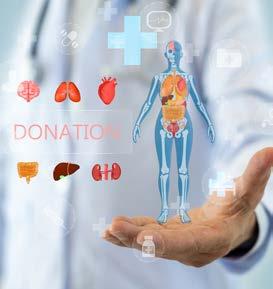
transplants; 2,075 pancreas transplants and 174 intestine transplants. The highest increases with respect to the previous year took place in lung transplants, which grew by 6%, and in liver transplants, with a 5% increase.
The success of the Spanish model is explained by the solid organisation of the National Organ Transplant Organisation, and by the international cooperation, which has allowed this model to be exported to other countries.
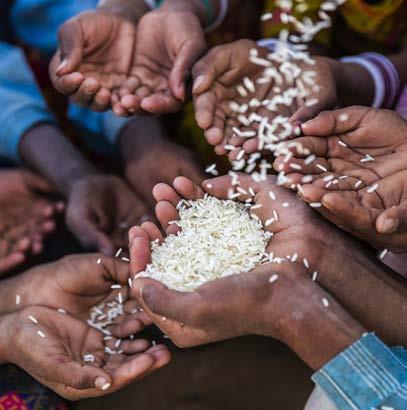
World hunger has decreased slightly in 2024, affecting 8.2% of the global population (673 million people), compared to 8.5% in 2023. However, the advances are unequal: whilst Southern Asia and Latin America are recording improvements, hunger still continues to increase in a large part of Africa and Western Asia, according to the report The State of Food Security and Nutrition in the World 2025 (SOFI).
The report also indicates that moderate or serious food insecurity affected 2,300 million people in 2024, still 335 million more than before the pandemic. In the nutritional plan, there remain important challenges: although the infant growth retardation dropped to 23.2% and exclusive breastfeeding increased to 47.8%, adult obesity rose to 15.8% and anaemia in women between the ages of 15 to 49 reached 30.7%.
Another central aspect of the report is food price inflation. Between 2021 and 2023, prices grew way above general inflation, reaching a maximum of 13.6% at the beginning of 2023. In low-income countries, the impact was even greater, with peaks of up to 30%. Although the number of people who cannot afford to have a healthy diet has dropped (2.600 million in 2024, compared to 2,760 million in 2019), in the poorest countries the figure has continued to grow.
The UN warns that the reduction in global hunger is promising, but insufficient and fragile. They demand more investment in agricultural transformation, social protection programmes and resilient food systems that guarantee universal access to healthy, harmless and nutritive diets.

The body transmits signals that we often ignore. Sudden pains, changes in our sight or persistent fatigue can be the forerunner of serious problems. Recognising them in time and consulting an expert will be essential in order to prevent certain diseases.
By Àngela Zorrilla
Recurring pain, blood in the urine, problems with your sight, difficulty in moving an arm… Although at times an anomaly can occur on its own and get better naturally, at other times it could be the first sign of a more complicated disease. But, how can we know when an urgent visit to the doctor is needed and when it isn’t?
In the first place, we must remember that doctors do not only treat diseases, they also help to prevent them. Therefore, it is essential to carry out all the regular health check-ups, such as ophthalmologic, gynaecological check-ups, in addition to a general health check-up every 2-3 years. It is also vital to keep your vaccination schedule up to date and to get advice from experts and specialists regarding how to prevent some certain problems.
A large percentage of serious diseases can be handled more effectively if the risk factors are controlled and above all, if the early warning signs are detected. Accordingly, for example, the WHO warns that recognising some symptoms can help to prevent up to 80% of heart attacks and although it is not always possible, to slow down the advance of some lung diseases.
Letting clear warnings go by, thinking that the discomfort or the health problem will end up disappearing by itself, can be dangerous. On the other hand, paying attention to certain signs is the best way to prevent cardiovascular, neurological or autoimmune problems, amongst others.
Carrying out regular medical checkups is important for detecting any possible health problems, identifying risk factors and knowing that you are looking after your personal well-being. Although these checkups vary according the background and the patient themselves, there are some normal tests:
Gynaecological checkup. This includes breast examination, a smear test for early detection of cervical cancer and ultrasound scans.
Cardiovascular checkup. It is recommended from the age of 45 years onwards and it includes tests such as an electrocardiogram or taking blood pressure.
Ophthalmological checkup. It is important to check visual acuity and hearing annually to detect and/or prevent problems that should be treated.
General checkup. It is important to do some blood and urine tests once a year to detect problems such as infections, diabetes or anaemia. Controlling weight and the correct functioning of the organs are also essential.
Prostate checkup. For men, it is essential to carry out an analysis of the prostate-specific antigen (PSA) every year particularly from 50 years onwards to detect any prostate problems.
It is essential to carry out all the regular health checkups, in addition to a general checkup every 2-3 years
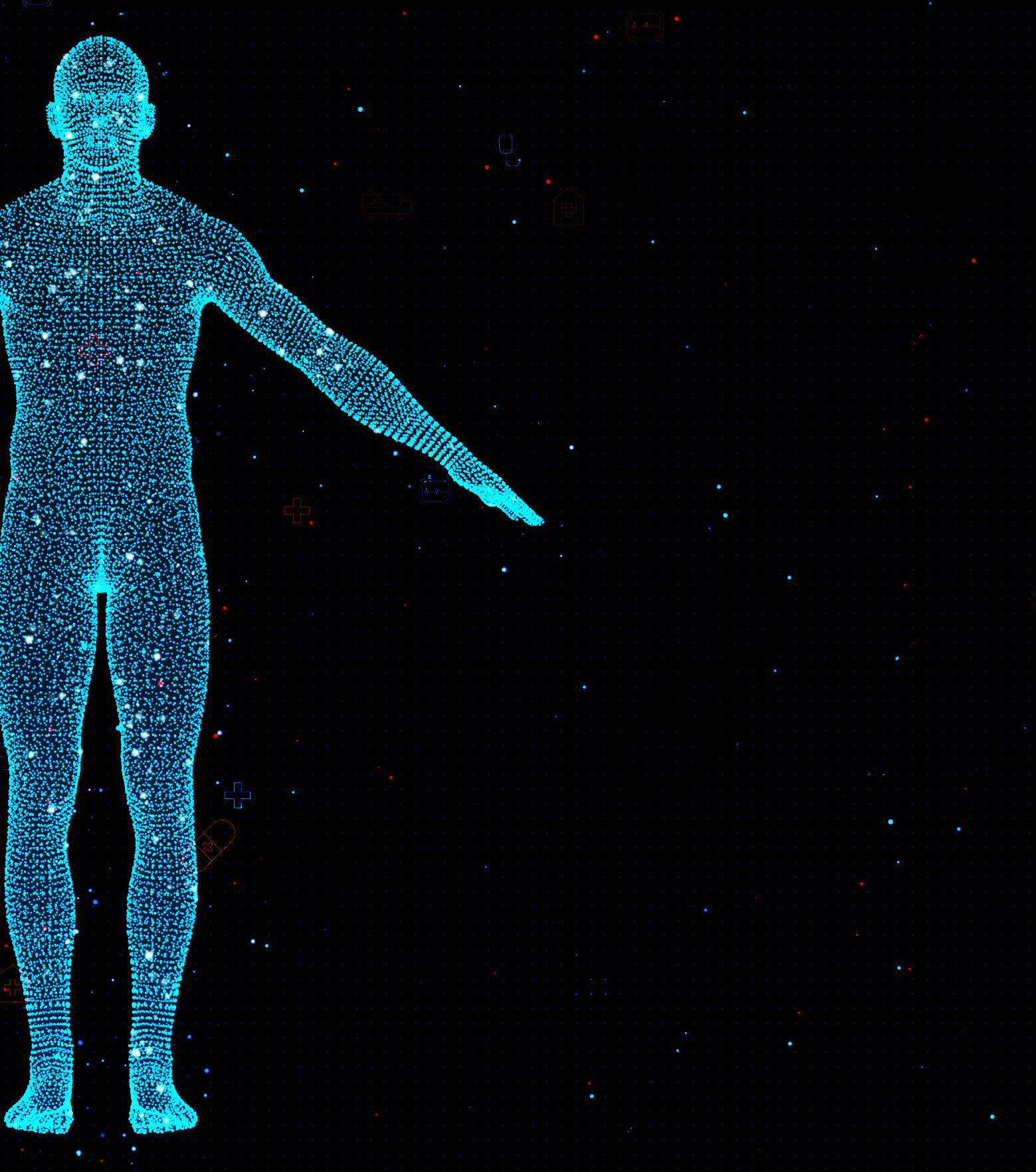
Health symptoms that need to be looked at
Listening to the body is one of the most effective steps when preventing serious health problems and maintaining your well-being. To do this, the best tool is knowing the main warning signs that can appear. These are some of the most common ones.
Symptoms of neurological problems
• Difficulty or changes in speech or vision.
• Dizziness or balance problems.
• Persistent headaches.
• Numbness in limbs.
• Muscular weakness
• Memory loss.
• Blackouts.
Symptoms of respiratory problems
• Shortness of breath.
• Breathing difficulties
• Extreme tiredness.
• Palpitations.
• Inflammation of the tonsils.
• Coughing.
• Chest discomfort or pain.
• Loss of voice.
• Ear ache.
• A high temperature.
• Chest pain.
Symptoms of digestive problems
• Abdominal pain.
• Nausea and/or vomiting.
• Heartburn.
• Burping.
• Early satiety or fullness.
• Abdominal swelling.
• Constipation or diarrhoea.
• Weight loss or gain.
• Bleeding with bowel movements.
• Difficulty in swallowing food.
Symptoms of cardiovascular problems
• Sight problems
• Persistent fatigue and weakness.
• Chest pain or discomfort.
• Breathing problems
• Palpitations.
• Nausea or vomiting.
• Swelling of the limbs.
Chronic pain goes way beyond just physical discomfort: it affects the moods, the sleep and the daily routine of millions of people. How can it be dealt with and what healthy habits can help to cope with it?
By Sílvia Cardona
Pain is described as an unpleasant feeling. Its perception depends on several factors and it is always a subjective experience. For all these reasons, it is very difficult to measure and the pain scale continues to be the tool most used to evaluate its intensity from 0 to 10.
According to how long the pain lasts, it is distinguished between acute and chronic. Chronic pain is the pain that lasts three months or more and it affects the person at least four days a week. The International Classification of Diseases ICD-11 distinguishes seven types of chronic pain: primary, oncological,
musculoskeletal, visceral, orofacial, neuropathic and postoperative. To a large extent, chronic pain affects the quality of life of those who suffer from it, interfering in their moods. It also usually occurs with a feeling of fatigue and sleep problems.
According to the Chronic pain barometer in Spain 2022, 25.9% of the adult population suffers from it, which is the equivalent to over 9 million people and it is more prevalent in women than in men. This report shows the great impact that this condition has on mental health, as it reveals that 22.2% of the patients suffer from depression and 27.6% from anxiety.
People suffering from chronic pain are referred to specialised units to receive diagnoses, treatment and continuous monitoring. In hospitals, the Pain units are devoted to pain management, regardless of its cause and symptomology. These are made up of multidisciplinary teams, generally professionals specialised in anaesthesiology, neurology, psychology, physiotherapy and nursing. In Spain at the moment there are 417 hospitals that have these units.

Previous studies indicate that the prevalence of chronic pain in Spain, between 2011 and 2016, was located at around 17-18% In comparison with the data from 2022, this figure shows a growing trend that could be explained by several factors: the increase in life expectancy (and the consequent aging of the population), the influence of unhealthy habits, as well as greater visibility of chronic pain and the increase in diagnoses.
Tackling chronic pain requires a holistic, multidisciplinary view. Identifying the cause can help to set down a suitable treatment, but this is not always possible. In these cases, the treatment usually is focused on alleviating the symptoms and improving the person’s quality of life. Amongst the most commonly used resources there are:
• Pharmacological methods with nonsteroidal anti-inflammatory drugs (NSAIDs), antipyretic analgesics or opioids.
• Psychological support and emotional accompaniment, particularly when suffering from anxiety or depression.
• Physiotherapy and rehabilitation, one of the key pillars in pain management.
• Relaxation techniques that help to manage stress. Amongst these, meditation, yoga and mindfulness stand out.
In most cases different treatments are combined to tackle this type of pain.
The lifestyle usually plays a key role in chronic pain. Patients are advised to acquire and maintain healthy habits such as the following ones:
•Carrying out regular physical exercise. This is decisive both for to prevent and to manage chronic pain. In contrast, physical inactivity causes a greater feeling of pain and fatigue. The recommendation is to alternate gentle aerobic exercises with strength exercises. This combination allows mobility to be improved, stiffness to be reduced, along with inflammation. It has also been shown that physical exercise improves the quality of life and reduces the pain.
•Having a good sleep hygiene is essential for sleeping well. There is a two-way relationship between sleeping badly and pain. Therefore, it is essential to respect some regular sleeping times, taking care of the room temperature, guaranteeing darkness at bedtime and avoiding the use of screens at least two hours before going to bed, amongst other things.
•Avoid tobacco and alcohol. These are substances that have been related to a worsening of pain and of nighttime rest.

Compared to complete rest, active recovery offers physiological benefits that improve muscular oxygenation, reduce inflammation and shorten the recovery time.
By Marta Burgués

After an intense training session, the muscles suffer fibrillar microfractures that the body must repair
For people who train regularly, be they elite athletes or fitness-lovers, rest days usually generate ambivalent feelings. On the one hand, the body needs to heal and stop; and on the other hand, there is the worry that not exercising means losing the physical fitness that has been hard to achieve. Here is where a revolutionary concept comes into play, which has changed the way of understanding resting: active recovery. Far from being a contradiction, this practice has been consolidated as the key to progressing in a more intelligent, efficient and sustainable way in the training process.
Contrary to popular belief, resting does not mean complete immobility. Active recovery consists of carrying out physical activities with a very low intensity and impact during the days when tough training is not been performed.
The aim is to not add more stress to the organism, but just the opposite: to stimulate the blood flow to aid muscle repair, reduce the feeling of fatigue and shorten the recovery times. It is the perfect bridge that allows the body to repair itself whilst maintaining mobility.
The science behind active recovery establishes that, after a training session, the muscles accumulate waste metabolites, such as lactate, and they suffer from fibrillar microfractures, which are responsible for delayed onset muscle soreness (muscle ache).
Complete rest allows the body to repair itself, but in a slower way. When carrying out gentle movement, it promotes the blood flow, which acts as a distribution and waste collection service: it takes nutrients and fresh oxygen to the damaged muscles and it carries away the waste products for their elimination. This process significantly accelerates the tissue reconstruction; it decreases inflammation and alleviates the stiffness.
With active recovery, the benefits are not only physical, but also mental. Remaining active in a gentle way releases endorphins, the well-being hormones, which improve the mood and fight the feeling of stagnation or frustration that often accompanies days with forced inactivity. Integrating active recovery in the routine is, basically, learning to listen to your body and respond by giving it just what it needs.

The golden rule in active recovery is low intensity. You must be able to maintain a conversation without panting and the activity must not generate any sharp pain. The aim is to move, not to sweat heavily. These are some of the most effective habits that you can do on your “rest” day:
•Walking: The most underestimated and accessible activity. A calm 20-to-40-minute walk through a park or on the beach is an excellent way of moving the legs and hips without any significant impact. It helps to relax your muscles and to clear your mind.
•Mobility and foam rolling: Devoting 15-20 minutes to working on joint mobility (ankles, hips, shoulder) and to using a foam roller or a massage gun on the overloaded muscles is incredibly beneficial. This myofascial auto-liberation breaks the adherences and the trigger points, returning the length and natural elasticity to the muscles.
•Swimming or aqua gym: Water is the ideal medium for recovery. The floatability eliminates virtually all the impact on the joints, while the hydrostatic pressure has a draining, anti-inflammatory effect. Gentle swimming or walking in the water allows a complete movement of the body with a uniform, gentle resistance.
•Gentle yoga or dynamic stretching: A restoring yoga or yin yoga session centres on maintaining postures for several minutes to work the connective tissue passively. It avoids intensive sessions of vinyasa or ashtanga. Gentle dynamic stretching, such as leg swings or drawing circles with the arms, are also a perfect option.
•Using an exercise bike or going for a gentle bicycle ride: Pedalling without resistance, at a rate that does not take any appreciable effort, is fantastic for promoting blood flow in the legs without the excentric loads used during racing.
Asudden cardiac arrest is one of the main causes of death in the world. It is estimated that, outside hospitals, only a fast intervention with resuscitation and defibrillation can improve survival rates. Every minute that goes by without action, means that the possibilities of the person recovering are reduced by around 10%.
The AED (automated external defibrillator) is a portable electronic device designed to analyse the cardiac rate of a person and, if necessary, administer a controlled electric discharge to reverse a serious arrythmia, such as ventricular fibrillation or pulseless ventricular tachycardia, which are frequent causes of sudden cardiac death.
All you need to know about an AED:
• It is automatic. The apparatus itself analyses the heart rate and determines if the discharge is necessary or not.
• It has a user guide with it including instructions that are both visual and audible, therefore it may be used by non-healthcare personnel in emergency situations.
• It is positioned using adhesive patches on the victim’s chest.
• It forms an essential part of the survival chain along with cardiopulmonary resuscitation (CPR).
In many places (airports, stations, shopping centres, sporting facilities) there are AEDs installed for public use, as their fast application multiplies the probabilities of survival after a cardiac arrest.
1. Evaluate the situation: Comprobar si la persona está inconsciente y no respira con normalidad. Llamar de inmediato al 112.
2. Start cardiopulmonary resuscitation (CPR): Check whether the person is unconscious and is not breathing normally. Immediately call 112 (emergency services).
3. Turn the device on: Start with chest compressions while someone else is bringing the AED.
4. Position the electrodes: Normally one on the upper right side of the chest and the other on the left side, below the armpit.
5. Follow the indications: The apparatus analyses the heart rate and decides whether a discharge is necessary or not. Nobody must touch the victim during this analysis.
6. Apply the discharge if indicated: Press the button only when the AED orders it. Afterwards, restart the CPR until professional help arrives or the person shows signs of recovery.
You should not be worried about getting it wrong: the AED will not allow a discharge if it is not necessary. You must remain calm and follow the device’s voice instructions. It is safe to use it on adults and children over the age of 8 years; for younger children there are specific paediatric electrodes. You must avoid using the device on wet or metallic surfaces.

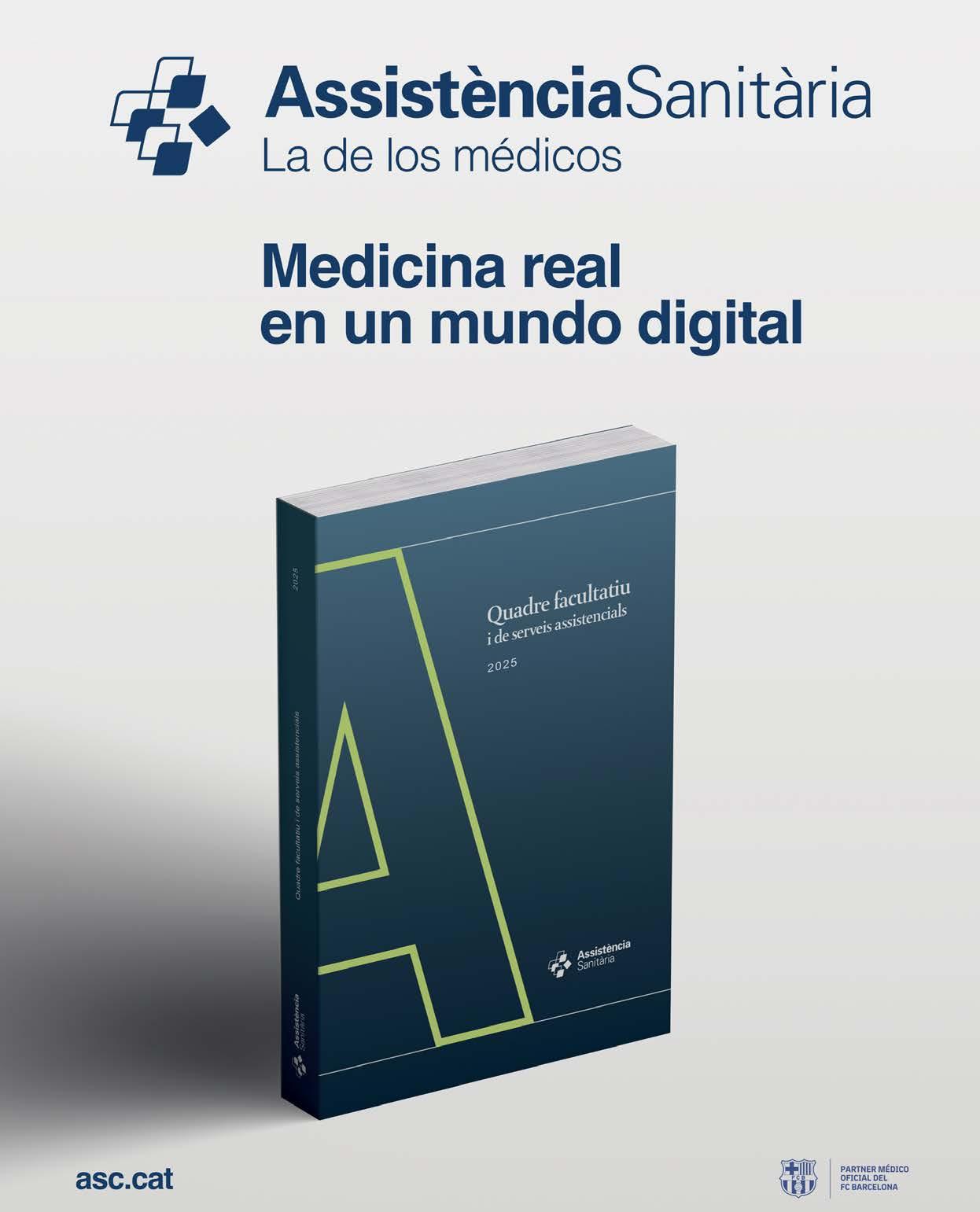
The ASISA Group had a turnover of 1,870.6 million euros in 2024, having grown by 6.2%.
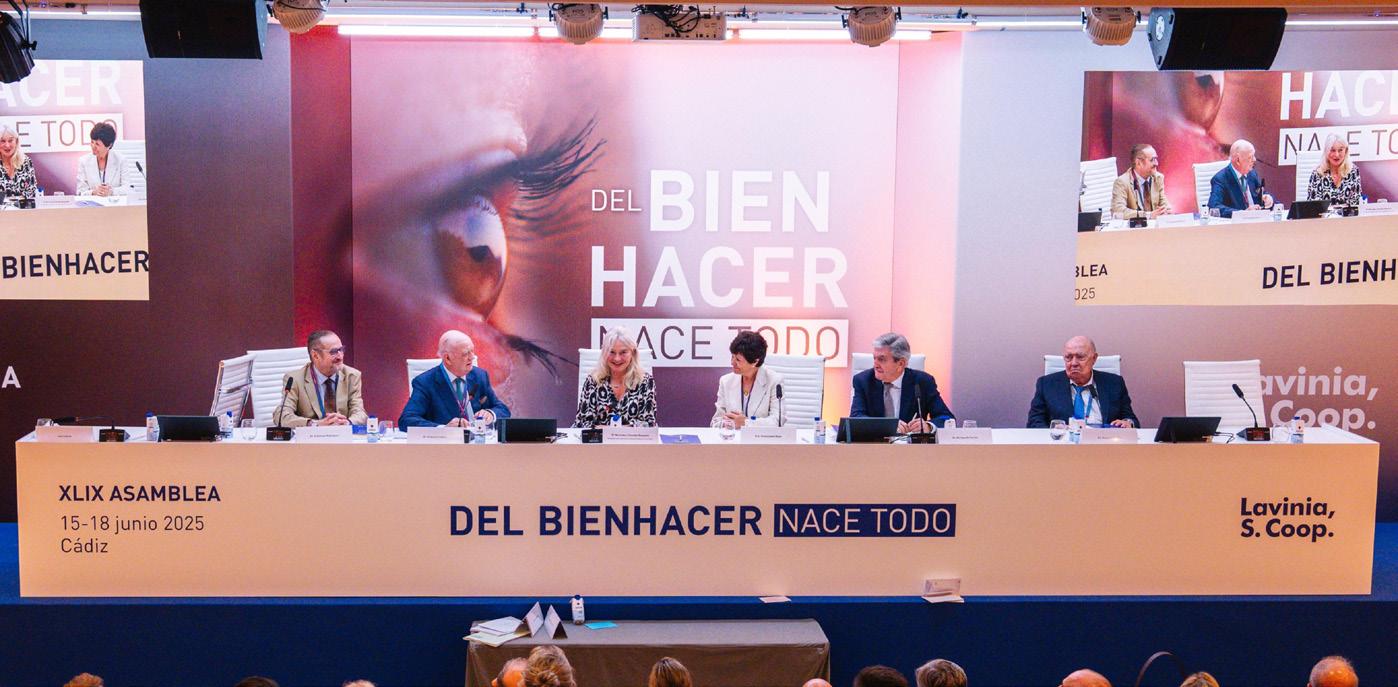
Lavinia S. Coop., ASISA’s sole shareholder, held its 49th General Assembly in Cádiz, analysing the company’s performance and results and reviewing the core elements of its strategy for the coming years.
In the medium term, the goal of the ASISA Group is to continue to drive forward the transformation of its model, diversifying its business in order to continue to grow, improving its profitability and investing in the modernisation and the expansion of its healthcare network.
This Assembly, held under the theme of “Work well done is the root of everything”, reviewed the main aspects of the ASISA Group’s activity over the past fiscal year, characterised by the virtual freezing of premiums for services covering government employees (they increased just 1.25% in 2024) and the effect of inflation and hospital concentration, which have led to an increase in costs and forced the sector to raise the rates for its insurance policies in recent years. Furthermore, the difficulties encountered when renewing agreements co-
ASISA has begun to market ASISA Mascotas RC, a civil liability insurance policy for dogs and cats which covers amounts specifically tailored to account for dog breeds which have been deemed potentially dangerous. This product enables the insurer to expand its insurance portfolio to meet the needs of dog and cat owners and, in the case of dogs, to help them comply with the requirements of current Spanish animal welfare legislation.
Up until now, ASISA Mascotas (ASISA Pets), the veterinary care insurance policy, included civil liability as an additional guarantee. The new ASISA Mascotas RC insurance product focuses
primarily on civil liability as its main guarantee, which is complemented with a veterinary care guarantee with significant discounts and the possibility of also adding optional coverage for theft, accidental death and the expense of putting a pet to sleep and disposing of its remains.
Civil liability insurance for dogs and cats is a protection for the pet owner, covering the costs that could arise from any damage or problems caused by the animal. In the case of ASISA Mascotas RC, the policyholder can choose up to three different amounts of maximum compensation (150,000, 200,000 or 300,000 euros) when taking out the policy.
vering government employees have generated uncertainty in recent months. In the end, after reaching an agreement with the Spanish Government, ASISA has renewed its participation in Muface, Isfas and Mugeju.
Against this backdrop, the ASISA Group closed 2024 with a consolidated turnover of 1,870.6 million euros, 6.2% more than in 2023.
The President of the ASISA Group, Dr Francisco Ivorra, stressed that: “These results prove that we know how to do things properly, and that we are able to continue to transform ourselves, driving our growth and expanding our business, both in insurance and healthcare”.
The Lavinia Assembly ratified the ASISA Group’s strategic plan for the coming years, which seeks to boost its growth, expand and modernise its healthcare network, export its model to new markets, move forward in its digital transformation and strengthen its commitment to sustainability and care for society and the environment.
The Assembly also renewed its support for the members of Lavinia’s Governing Council, the co-operative’s highest executive body, which renews half of its members every two years, and ratified Dr Francisco Ivorra as its Chairman.


This hospital has created a Robotic Surgery Unit with a multidisciplinary team of specialists accredited.
HLA Vistahermosa Hospital has expanded its portfolio of services with the acquisition of the Da Vinci robotic platform, the first surgical robot to be installed in a private healthcare service in the city of Alicante. This tool, the most modern and advanced surgical robot available, will be fully operational in the third quarter of this year, when the first operations are scheduled.
In order to offer its patients the greatest possible access to this technology, HLA Vistahermosa has created a Robotic Surgery Unit made up initially of specialists accredited to use this technology. The unit has specialists in digestive system surgery, urology, gynaecology and thoracic surgery, coordinated by surgeons Dr. Ruiz de la Cuesta, Dr. Cándido Alcázar and Dr. Mariano Franco, together with urologist Dr. Carla Pérez. This multidisciplinary team will allow the hospital to offer access to robotic surgery techniques to a large number of patients with a range of conditions.
The Da Vinci robot is a minimally invasive technology that enables complex surgeries to be performed more safely, cancelling out the surgeon’s hand tremors and providing an immersive 3D vision that enables high precision in the surgical technique, and leads to lower rates of postoperative complications, shorter hospital stays, better oncological results and greater quality of life for the patient.
The experience built up since 2017, when the first Da Vinci was installed at HLA Moncloa University Hospital, currently the private centre that performs the most operations in Spain with this technology, has provided the HLA Group with teams with a long track record in robotic surgery, examples of good practice and an internal model of ongoing training.
The ASISA Foundation, HLA Moncloa University Hospital and the Universidad Europea of Madrid (UEM) held the graduation ceremony for the tenth class of doctors trained at the HLA Group hospital. At this event, held at the HLA Moncloa University Hospital, the new doctors took the Hippocratic Oath.
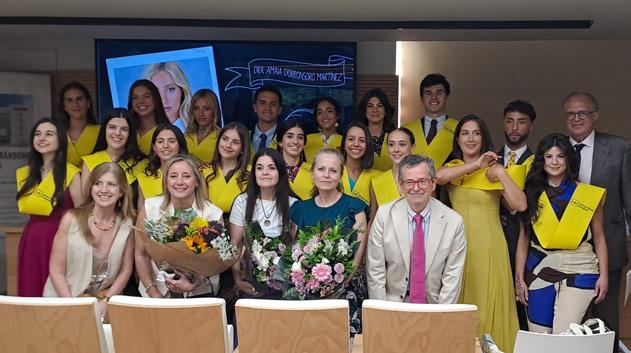
During the last three years of their medical degree, the clinical cycle, the students of the 10th class have received extensive training from more than a hundred medical doctors, adjunct professors and practice tutors at HLA Moncloa University Hospital, and have rotated through all hospital areas. The ASISA Group’s commitment to the training of new generations of doctors began in 2006 and is in line with the research carried out by the ASISA Foundation.
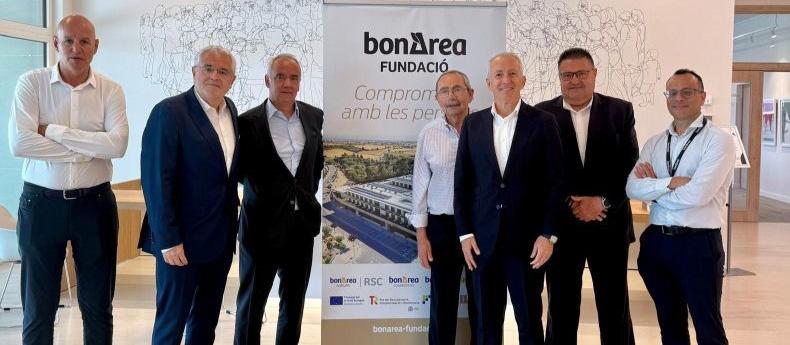
ASISA and the bonÀrea business group, whose headquarters are in Guissona (Lleida), have held a meeting with the aim of strengthening their relationship and seeking synergies which will enable both organisations to launch new projects in the field of insurance. This meeting was attended by executives from both companies. Present on behalf of ASISA were Dr. Antonio Mateu Serra, the Lleida representative; Jaime Ortiz, Sales and Marketing Director; Alfonso Porcel, Territorial Director; and Juan Carlos Batalla Jovell, Manager of ASISA Lleida. The bonÀrea Agrupa representatives were Ramón Alsina, Managing Director; Vicenç Brieba Farrero, Head of the SEAGUI Insurance Department; Joan Ruich, Director of the bonÀrea Foundation; and Xavier Moreno, Head of the bonÀrea Agrupa Human Resources Department. At this meeting, ASISA and bonÀrea agreed to continue to seek opportunities to work together to offer high-quality services and build solid alliances based on trust and collaboration. Apart from its activity in the agrifood sector, the bonÀrea group offers commercial and consultancy services to both companies and individuals, including insurance.
HLA Mediterráneo Hospital acquires a new world-leading system
HLA Mediterráneo Hospital in Almería has taken a new step forward in the diagnosis and monitoring of respiratory diseases thanks to the acquisition of the new Vyntus ONE pulmonary function system, a cutting-edge technology used in the world’s leading hospitals in respiratory diseases and which, in Andalusia, was only available in Seville. The Vyntus ONE system enables a comprehensive assessment of lung function, meeting the highest international standards of diagnostic quality. This equipment, currently used in leading hospitals worldwide, enables tests such as spirometry, plethysmography and diffusing capacity (DLCO) to be performed with optimal reliability and in less time.

With a very substantial number of policyholders who live in el Vallès Occidental, Assistència Sanitària is taking another step forward in its commitment to the area and is moving its Terrassa branch to new premises located in a central and well-connected area of the city.
The new Terrassa office will bring the organisation’s services closer to thousands of users in this city and its surrounding county, improving accessibility and moving closer to policyholders. Assistència Sanitària is well established in this city, with a significant track record in the field of healthcare and personal services, with an extensive medical and personal support service network. In the words of Dr. Ignacio Orce, President of the insurer, “it is worth stressing the importance of this opening as part of our organisation’s natural expansion strategy in a region that stands out for its remarkable growth and for having a high concentration of people linked to the organisation, and where we are already present, with offices in Sabadell and Sant Cugat”.
The new office offers in-person services for all the most frequent procedures - information, operational queries, service requests or contractual issues - and has a convenient, warm and open design. The space has been designed to be user-friendly, to provide a comfortable environment for both clients and staff, and to adapt to the changing requirements of high-quality private healthcare.
With this new venue, Assistència Sanitària has strengthened its network of customer service locations, which now totals more than 20 branches across the area in which it operates, thus strengthening its presence in one of the organisation’s most important geographical areas.
SCIAS joins the Josep Carreras Foundation in the fight against leukaemia

SCIAS Hospital de Barcelona has signed a collaboration agreement with the José Carreras Leukaemia Foundation to host a number of social awareness and support actions in its facilities. The initiative is part of SCIAS’ firm commitment, as a healthcare co-operative, with medical research, corporate social responsibility and the development of a more humane and socially committed healthcare. This agreement will enable the José Carreras Foundation to implement information campaigns within the hospital to raise awareness of haematological malignancies and encourage the public to get involved in their eradication.
“Social commitment is an essential part of our identity as a co-operative. We understand that our role is not limited to providing healthcare: we must also promote research, support causes which transform lives, and stand alongside those working for progress in medicine,” stressed Andreu Obis, Chairman of the SCIAS Governing Board, during the signing ceremony of this new agreement. This agreement already includes three scheduled awareness-raising days, in October and December 2025 and in February 2026.
Hospital
On 7 November, a free, in-person conference on health during pregnancy will be held, organised by Assistència Sanitària in collaboration with the Internal Medicine, Paediatrics and Neonatology departments of Hospital de Barcelona, as well as specialists in gynaecology and obstetrics. Throughout the morning, topics of great current interest and clinical relevance will be addressed, such as the need for infection screening during pregnancy, the impact of cytomegalovirus (CMV) on both pregnancy and the newborn, and the risks posed by chorioamnionitis — an infection that can endanger the lives of both mother and baby. In addition, recent advances will be presented regarding the possibility of early detection of breast cancer through components found in breast milk, in a talk given by oncologist Cristina Saura.


The health insurer continues to offer free healthcare coverage as part of a programme, launched in 2018, which has enabled 18 young people to resume their university studies.
Assistència Sanitària has recently renewed its commitment to the programme to welcome refugee students from Lebanon, an initiative promoted by the Catalan Government in collaboration with a number of universities and international organisations. Following the successive annual renewals, the insurer will continue to offer free medical coverage to the students who take part in this programme.
Since its inception, this collaboration has guaranteed access to health care - an essential condition for a student visa - to a total of 18 young refugees, mostly of
Syrian origin, but also Palestinian and Pakistani, who fled the armed conflict in their countries of origin and were living in Lebanon. Thanks to this programme, they have been able to continue their higher education studies at several Catalan universities.
“As doctors, we believe in knowledge as a tool for transformation. This agreement is a natural extension of our commitment to education and social improvement”, declared Dr Ignacio Orce, President of Assistència Sanitària, when signing the new extension of this agreement.
More than 40 people from Assistència Sanitària’s sales teams and branches met at Hospital de Barcelona, the exclusive reference healthcare centre for the organisation’s policyholders. This event was a chance to meet and strengthen coordination between branches, share objectives and jointly analyse sales.
During the first part of the event, participants attended work sessions and group meetings, focusing on exchanging knowledge, sharing strategies and developing the new range of products and services that the company is preparing. The aim of these new products and services is to adapt to the current needs of people who seek the highest standards for their healthcare, providing innovative solutions and ongoing focus on quality of care.
The attendees then had the opportunity to see Hospital de Barcelona up close and learn about its most recent projects. Among the new developments showcased during the visit were the new entrances to the Emergency and Admissions Area, the extensive renovation of several floors of inpatient rooms, and the hospital’s own clinical laboratory, AssislaHB, which processes all of Grup Assistència’s labwork requests.

Dr Pérez-Hervada, who is also Deputy Medical Director of SCIAS-Hospital de Barcelona, has expressed her commitment to supporting high-quality medicine, based on a tight and effective collaboration between the laboratory teams and professionals across all specialities.
Among the laboratory’s resources which are already in operation are the warning circuit that alerts of
critical values and the quick resolution system for incidents and queries, both managed by a team of highly qualified doctors, headed by Dr. Beatriz Candás, providing easy access and constant availability.
Aware of the challenges involved in launching such a project, the new co-ordination team aims to promote fluid, two-way communication, integrating the expe -
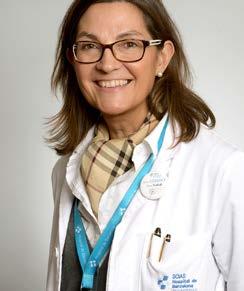
riences and suggestions of Grup Assistència professionals with the aim of perfecting every process and bolstering the efficiency and quality of the service. These professionals were also personally invited to visit the laboratory’s new facilities and see first-hand how they work, highlighting the desire to turn AssislaHB into a benchmark model, focusing on diagnostic excellence and patient care.
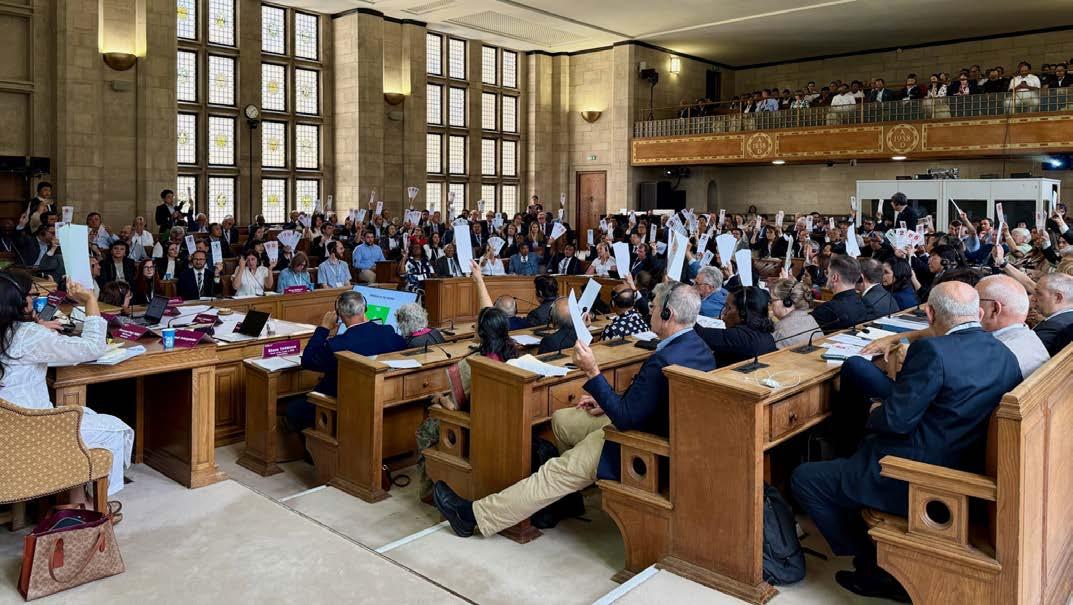
The ICA brought together delegates from all over the world to define the route to be taken by the cooperative movement as a driver of global transformation.
On the 2nd of July of this year, the historic city council of Manchester, the cradle of the modern cooperative movement, hosted the General Assembly of the International Cooperative Alliance (ICA). The meeting brought together 400 delegates from all over the world in the city where, in the 19th century, a business model was born that today groups together almost 1,000 million people.
The opening session was presided over by Carmine Grinshwa, Lord Mayor of Manchester, who underscored the city’s cooperative legacy and its close links with the values of the ICA. The British federation, Co-operatives UK, which represents over 7,000 cooperatives that are currently active in the United Kingdom, acted as the meeting’s host. The Fundación Espriu took part in the assembly represented by its General Director, Dr. Carlos Zarco.
During the meeting the ICA’s strategic plan for the 2025-2030 period was approved, based on the theory of change, which positions the
organisation as a global agent of transformation. It is a strategy of movement, rather than a simple management plan, which sets as priorities the promoting the cooperative advantage, encouraging the creation of new companies, strengthening leadership by women and young people, promoting research and training, taking advantage of technological platforms, intensifying the political incidence, moving forward in sustainability and guaranteeing the financial growth of the movement. The assembly also tackled the situation in Ecuador, where a recent legal reform threatens to force savings and credit cooperatives into becoming limited liability companies, a precedent that could have serious consequences for the entire region.
The Manchester agenda was completed with a new session of the Cooperative Leadership Circle (CM50), which continued the meeting organised in May by the Fundacion Espriu in Madrid. Dr. Zarco took an active part in the debates by this group that brought together
the leaders of the largest cooperatives and mutual societies in the world. The members of the CM50 decided to concentrate their efforts on three priority areas: the reconstruction after conflicts, the promotion of education and cooperative governance and the creation of a global cooperative market.
Looking towards the future, the CM50 will meet again in Doha, within the framework of the UN World Summit on Sustainable Development that will be held from the 4th to the 6th of November. There, the CM50 Manifesto and the Commitment Plan will be officially launched, along with the presentation of a special issue of the World Cooperative Monitor and the closing ceremony of the International Year of Cooperatives.
With these decisions, the ICA and the CM50 are strengthening their role as global benchmarks and they are reaffirming the validity of cooperativism as a driver for sustainable and equal development.
On the 1st of August of this year, the Fundación Espriu organised an informative session at the HLS Hospital Universitario Moncloa, aimed at a delegation of the Brazilian Cooperatives Organisation (OCB). Over 40 representatives from the 27 state divisions that structure the entity took part in the meeting.
The session included the intervention by the General Director of the Fundación Espriu, Dr. Carlos Zarco, who offered a panoramic view of healthcare cooperativism in Spain. Amongst other aspects, his presentation covered the composition of the Fundación Espriu and the entities that form it; the context of cooperativism, the healthcare system and health insurance in Spain; as well as the dimension and activity of Assistència Sanitària and ASISA, emphasising
their impact on the development of social medicine. He also gave a review of the historic evolution of health cooperatives in our country.
The OCB, the organism that represents the Brazilian cooperative movement on a national and international scale, is aimed at promoting this model before the executive, legislative and judicial powers. Its work centres on making visible the benefits that cooperatives contribute to people, the economy and the planet, in line with the principles of sustainability and inclusion.
The meeting allowed links to be tightened between both organisations and the exchange of experiences regarding the role of cooperatives as drivers of social transformation to be strengthened.
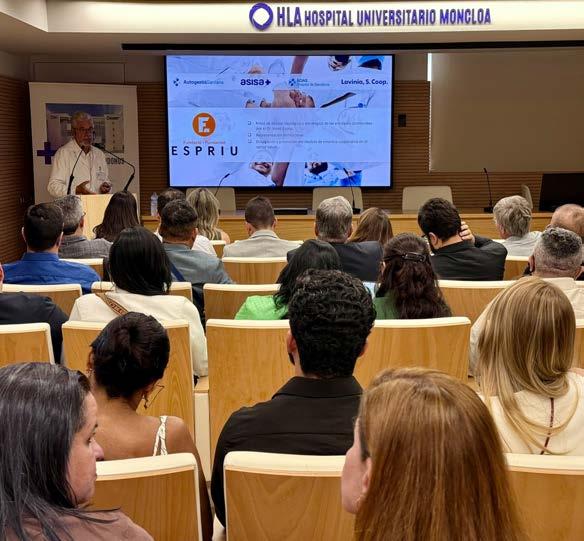

Are cooperatives ready to implement the Sustainable Development Goals? To respond to this question, a session of the United Nations High-level Political Forum was held in New York on the 15th of July. The meeting brought together representatives from Member States and development agencies alongside cooperative leaders from all over the world.
Carlos Zarco, General Director of the Fundación Espriu intervened at this meeting, emphasising the role of health cooperatives in achieving the SDG3: good health and well-being. He recalled that over 100 million people in over 70 countries have access to healthcare through cooperatives, which offer a wide range of services: primary care, hospital management, pharmacy networks, insurance, telemedicine and care for the elderly.
Dr. Zarco underscored the fact that the democratic governance of these entities encourages innovative solutions adapted to the needs of each community, such as home care and digital services. He also underlined the fact that health cooperatives complement the public systems and extend healthcare cover, reinvesting their excess in training, infrastructures and technological innovation.
These ideas were backed by the documents that the United Nations made public in July. The report by the Secretary General on cooperatives in social development emphasises the capacity of these organisations to eradicate poverty, create decent employment and to promote social cohesion. In particular, he underlined how health cooperatives extend access to healthcare and offer an approach that is centred on people and on the community.
The Ministerial Statement of the High-Level Political Forum insists on the fact that health is essential for sustainable development and it calls to strengthen the health systems, moving forward towards universal healthcare cover and to improving the preparation against pandemics and other emergencies. The recognition by the United Nations, along with the experiences shared in the forum, confirm that cooperatives are key actors for building inclusive, resilient health systems, capable of speeding up the fulfilment of the 2030 Agenda.
The scientific advances derived from research and the chance to cultivate healthy habits allow people to imagine a different way of facing up to the start of their more mature years.
By Enric Ros
There were times, not so long ago, when anyone who had reached their fifties were considered to be an elderly person. Today, our society seems to be obsessed with reaching perpetual youth. But: is it really possible to face up to the years healthily, delaying the undesirable physical effects that we usually associate with old age?
In order to analyse this question, we talked to Tamara Pazos, a brilliant young scientist who studied for a Master in Neuroscience and who has written interesting books with titles such as Crecer sin envejecer (Grow without aging), Este Libro te hará vivir más (o por lo menos major) (This book will make you live longer (or at least better) and La biologia aprieta pero no ahoga (Biology pinches but it doesn’t choke) (all of them published by Paidós). In her opinion, the information we have available to us today gives the new generations the chance to age in a different way. Additionally, now we are seeing “a great research effort and investment in biomedicine, completely aimed at studying these cellular aging processes and illnesses associated with this.
The chronological age will unavoidably, continue to move forward, but the biological age will depend on how much we have looked after ourselves
much we have looked after ourselves. “According to the context and the access to healthcare resources, there will be people who are seventy years old with a young, functional immune system, who are able to face up to and repair the damages derived from the passing of the years. And there will be other people who, due to an accumulation of stress, physical inactivity, environmental pollutants, lack of sleep, etc., who will have a deteriorated immune system that will speed up the aging process. The greatest differences will be found linked to the socio-economic status and the possibilities of access to these scientific advances,” Pazos explains.
The first thing that we must consider is that the chronological age will unavoidably, continue to move forward, but the biological age will depend on how
The science of longevity offers us a chance to change our mentality. “The idea is not to add years of life, but to add life to the years,” this researcher affirms. And she adds: “The science of longevity is showing us that aging is pliable and that we can influence how our immune system ages, which acts as the conductor for an orchestra of many other processes. A healthy immune system not only responds well to infections, it also keeps inflammation at bay which, when it becomes chronic, encourages cardiovascular, neurodegenerative or metabolic disease. Understanding this allows us to design specific strategies to help us to reach advanced ages in a better physical and mental state.


Tamara Pazos is clear that the immune system must always be at the centre of the conversation about longevity. In order to look after this system, we must take the following four fundamental pillars into account:
1. Movement: “Regular exercise trains immunity, improves the circulation of the defensive cells and reduces inflammation.”
2. Rest: “Deep sleep is the moment when the immune system reorganises and repairs itself.”
3. Diet: “Dietetic patterns based on vegetables, legumes, dried fruit and fish provide nutrients that regulate the defences and prevent their constant activation.”
4. Social relations: “Isolation is one of the greatest accelerators of immunological aging, whilst social support protects it.”
It is very important to know which factors contribute to maintaining this essential physiological reserve that allows us to face up to our daily routine in spite of getting older.
It is clear:
one of the secrets for facing up to maturity successfully is to always keep active and healthy.
As indicated by Ignasi Bardés, a doctor who specialises in family medicine and geriatrics, an essential element for meeting this target is to “preserve our physiological reserve.” This concept refers to the essential organic capacity to be able to face up to our

daily activity. Obviously, “as we get older, this reserve drops until reaching a point of fragility, where we cannot yet consider that we are truly ill, but where we find ourselves at the limit for meeting our needs” Bardés affirms.
holistic view
Maintaining and increasing the physiological reserve as much as possible is revealed as a primordial element. To do this, we must take into account – as indicated by Bardés, “several dimensions which, when they are in harmony, form a true virtuous circle: exercise and nutrition are, without any doubt, fundamental for maintaining a physical constitution where there is more protein than fat. But it is also


very important to maintain an active cognitive life and know how to look after the social and emotional spheres.
This is not just an individual challenge, but rather it demands a global involvement that means a transformation of the way society looks at old age. In Bardés’ words, “we must change the concept that we have today of the older generation. Instead of limiting ourselves to considering that they are people who have already played their part, we can integrate them a great deal more, take into greater consideration all the knowledge and experience that they can still give us.”
Bardés’ holistic approach fully coincides with that of the World Health Organisation (WHO), which defines “active aging” as a “process that optimises the health, participation and safety opportunities to improve people’s quality of life as they get older.” Obviously, this involves several different variables: personal (such as each person’s biological and genetic condition, or their personality) as well as behavioural (those related to habits and lifestyles.)

We must add the unavoidable impact of external determining factors (social, economic, environment or infrastructure and healthcare services) to all these aforementioned elements.
Exercise and nutrition are essential, but is also very important to maintain an active congnitive life
For Tamara Pazos, “the fundamental point is to maintain the homeostasis, that is to say, the organisation’s capacity to regulate its hormone production signals. These are linked to satiety, sleep, emotions or pain” and also to how our organs and our behaviour react to these signals in an optimum way for survival.
“In order to do this, we need to be constant in the basic areas: moderate, regular physical exercise, quality rest, a diet that is rich in fibre, antioxidants and healthy fats and good stress management. It is also important to cultivate activities that give us enjoyment and social connection: laughing, sharing, learning new things. All of this regulates both immunity and hormone production. The truth is, we are not talking about spectacular interventions, but rather simple routines which, if followed over time, are the true preventive medicine,” Pazos adds.

•Chronic stress. According to Tamara Pazos, “it keeps the body alert with high levels of cortisol that weaken the defences and encourage inflammation.”
•El sedentarismo “prevents the immune cells from activating and circulating efficiently.”
•La alimentación based on highly processed products and sugars “makes low grade inflammation shoot up, which is the true background noise behind aging.”
The report ‘A profile of the elderly in Spain,’ edited by the CSIC, showed a series of data about the living conditions of people aged 65 years and over in its 2024 edition, which allow interesting conclusions to be reached about how old age will be in the near future in our country.
Of the 48,085,361 Spanish citizens, over 9.5 million people (9,687,776) are 65 years old or over, which represents 20.1% of the population, according to data from the National Institute of Statistics (INE) from 2023.
The older population continues to gain importance year after year. According to the INE’s projection (2023-2041), in 2041 we could reach a figure of over 14.5 million elderly people, 27.9% of the total of a population that will be over 52 million.
14,660
have already reached the age of 100 years or more. Compared to 2022, the number of centenarians has increased by 5.4%.
As the age increases, women exceed men in numbers. For the year 2023 and the age band of 65 years and over, there is a total of 5,474,236 women, 29.9% more than men (4,213,540).
Spanish provinces with the highest percentage of older people
Spanish provinces with the lowest percentage of older people


According to the INE’s latest mortality tables, based on data from 2022, life expectancy at birth is 83.08 years and it is recovering the rising trend that dropped due COVID-19, although without reaching levels prior to the appearance of the pandemic when the indicator reached 83.53%.
In recent times a new parameter has started to be measured: life expectancy in good health from 65 years onwards. According to Eurostat data, the evolution of this indicator is slightly lower in women, in spite of what could be expected (75.3 years compared to 75.7 years for men).
In 2023, 63.6% of people aged 65 years and over confirmed they had an illness or a long-term health problem. Nevertheless, this percentage has gradually decreased.
38.5% of people aged 65 years and over never carry out any physical activity in their leisure time, a figure that represents 33.4% of men and rises to 42.5% amongst women.
42.5 % 33.4%
However, as people get older, there is an increase in those suffering from chronic illnesses. For 2023, in the 65-to-74-year age group, in Spain these illnesses affect over half of older people, and in the next age group (from 75 to 84 years), the percentage increases to 68%. For people over the age of 84, chronic health problems affect 75.4%.

According to the 2023 European Survey on Income and Living Conditions (EU-SILC), in Spain, 37% of people aged 65 years and over suffer from longterm health problems or illnesses. In the case of the European Union as a whole, this figure drops to 35.1%.
Currently, a person who has reached the age of 65 year can expect to live an average of another 21 years (84.06 years for men and up to 87.96 years for women.)
“Having a vital purpose is an elixir for long life”
Considered to be one of the Spanish scientists with greatest international prestige, López-Otín has researched cancer and the ways to beat aging in depth. At the same time, he has written relevant informative essays that reflect on all these questions. His view brings together the advanced knowledge provided by science and humanist wisdom.
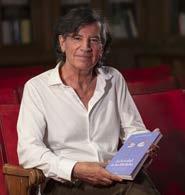
Dr. Carlos López-Otín
A Member of the European Academy and of the Spanish Royal Academy of Sciences. During his career in research, he has worked at the Hospital Ramón y Cajal and at the Severo Ochoa Molecular Biology Centre, in addition to several foreign universities.
What do you think is the belief held regarding aging and death in our societies?
Our relation with both biological processes is complex and often highly unsatisfactory. It is not simple to accept that aging and death are natural processes that have accompanied us throughout our evolutive history and that have been fundamental since 3,800 million years ago when life started to make its way on our planet. I always remind my students that, in order to move forward, life had to invent death. I myself, accept aging and death with complete normality. I do not believe in immortality; the aspects that occupy and concern me are the illnesses associated with the passing of time, not aging itself. My work does not involve trying to beat it, but rather trying to understand it, firstly in molecular and cellular terms and more recently delving into social and emotional aspects in greater depth. And with regard to death, I become overwhelmed when a death is inopportune, a death derived from hereditary or minority illnesses for which there are no suitable therapies, a death that arises from common pathologies that science and medicine can only pitch a partial and insufficient knowledge at present. But these insufficiencies cannot be used as an excuse to make an ode to ignorance and promote it from positions of power and influence.
To a certain extent, you wrote your first book in the “Trilogy of Life”, ‘La vida en cuatro letras’ (Life in

four letters – Paidós), to “help yourself”, since, as you have explained, you had lost your purpose in life. What importance does this vital purpose have on our health and long life expectancy?
I was educated by great masters and mentors in the study of the molecular and cellular keys of life and disease. However, the passing of time and our own scientific work have shown me that there are other factors, including social and emotional ones, which have a decisive influence on our health and long life expectancy. Amongst these, the fact of having a vital purpose is a good elixir. There are many types of ikigai, therefore each of us must find our own and assume the fact that you cannot last for ever. For me, the concept of a vital purpose is very solid when I consider the long-term, but necessarily dynamic in the ways to face up to it.

What factors could we indicate as important for a healthy long life expectancy? Which positive habits can we develop for an improved old age?
In my last book, La Levedad de las libélulas (The Lightness of dragonflies) (Paidós), I have reflected in depth on these questions and I have proposed a health equation that summaries my thoughts on this point This formula condenses an idea based on the fact that health is derived from nine dynamic characteristics that maintain the functions of our organism and that ensure our physical and emotional well-being. The first three keys cover the more strictly molecular aspects and can be specified in three ideas – space, time and regulation, which seek to ensure everything that should happen in our bodies happens in its place, at the right time and in perfect coordination. However, the art of health is much more complex
“What concerns and worries me are the diseases associated with the passage of time.”
and includes other factors related to our particular lifestyles regarding nutrition, exercise and sleep, while we try to avoid negative aspects such as stress and toxicity both environmental and human. Finally, I have incorporated a ninth key, the psychosocial adaptation that attempts to put the aspects relating to emotional well-being into a molecular context, while indicating that the deficiencies of this area are behind the epidemic of sadness that is spreading through our society.
Will the new generations age better than their predecessors? Will the difference between the biological age and the chronological age increase?
One hundred years ago, in highly advanced countries, the average life expectancy was around 35 years. Today, in Spain this figure is over 80 years and there are around 20,000 centenarians. These figures are going to increases, and I hope that the scientific, medical and social advances determine that we all live a little more and above all, a little better.
Should older people play a more active role in our society? Will this happen in a near future?
This is a very difficult question, as what is perceived in general is a lack of respect, disdain, neglect and margination towards the older generation. On the other hand, I have been lucky enough to know marvellous professionals in the field of geriatrics and in primary care, who give exceptional, exemplary care for old people. My parents spent their last years in the local home for the elderly in the village where I was born and I cannot put into words my gratitude to all the staff who looked after them with never-ending respect and love. We are, therefore, faced with a dilemma that we can only face up to with one word: education. The level of education of our society and the definition of its real priorities – not the ones that are quoted, but are then not fulfilled, will be the one that determines the role that the older generation will have to play in a future in which they will represent most of the population.
The palette of reds, ochres and golds that stain both trees and leaves during this season invites you to lose yourself in nature more than ever.
By Neus Duran
If getting lost in a forest is always a pleasure for the senses, without any doubt, in autumn it is even more so, with the languid falling of the leaves and the warm palette of ochre, gold and red tones colouring the landscape. Whether it is to go looking for chestnuts or mushrooms, animal watching or just to forget the rush of everyday life for a few hours, a stroll through the forest is always a good idea. In this article, we propose some of the most spectacular ones.
During the autumn, the calls of the rutting deer echo around the Selva de Irati
The Black Forest in Germany is the only beach and fir forest that is larger than the Irati Forest on the continent. In this small green paradise, located in the Eastern Pyrenees in Navara and that covers over 17,000 hectares, the brooks and streams abound, meaning the freshness and the murmuring of water accompany walkers on their journey. It is populated by many species such as foxes, trout and wild boars and in the autumn, the rutting deer can be heard, with their bellows that reverberate around the forest. The forest is also inhabited, according to local folklore, by characters such as the ‘Basajaun’, the lord of the forest, a long-haired giant, or the ‘lamias’


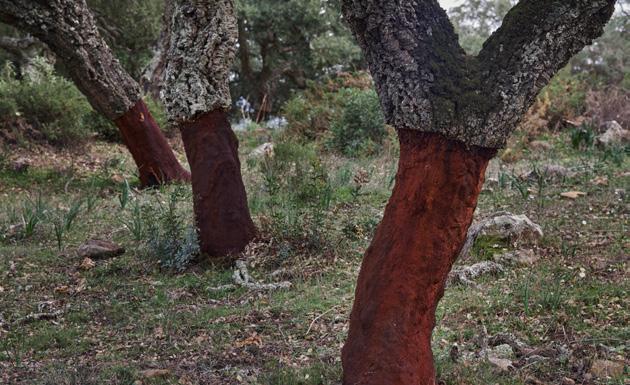


1 Irati Forest
2 Enchanted Forest/Pijaral Nature Reserve
3 The Forest of Los Alcornocales 4 Fageda d’en Jordà 5 Fragas do Eume
(Basque mythological characters), who hide in the rivers and springs. There are endless options to choose from, such as the interpretative path of Errekaidorra, a museum-like route that is 10 kilometres long that shows how the natural resources of the forest were historically used.
2 Enchanted Forest /Pijaral Nature Reserve
A thick, ghostly mist giving the feeling of the forest in Jurassic Park will receive visitors when they enter the Pijaral Integral Nature Reserve. This protected area in Tenerife hosts endemic species such as the Woodwardia radicans, also known as ‘píjara’, a species of fern that can measure up to three metres that gives its name to the area.
One of the most spellbinding corners of the Pijaral is the path known as the ‘Bosque Encantado’ or Enchanted Wood, which follows a circular route of around 7 kms, along paths completely covered by forest ferns. It should be noted that to do this route, you must apply for a permit a few days beforehand from the Tenerife Island Council.
3 The Forest of Los Alcornocales Cork, which has been harvested for centuries, is the true star in Los Alcornocales Natural Park, which

spreads over 170,000 hectares of land in between the provinces of Cadiz and Malaga. It is the largest forest of cork oaks on the planet.
It can be crossed following a path that ascends to El Picacho, from which there is an impressive panoramic view. With luck, you will see some of the fauna species that inhabit the park, amongst which the eagles stand out.
4 Fageda d’en Jordà
The fact that it is located on the cooled wash of a volcano makes Fageda d’en Jordà a unique setting. In the autumn, the blanket of leaves tinged in ochres and reds contrasts with the lava protrusions covered in green moss that rise up from the ground and that can reach over 20 metres in height.
This leafy forest in the Garrotxa, which has always been a source of inspiration for painters and poets, may be visited along a very short, simple, circular circuit, suitable for all. Other more ambitious routes of around 12 km, will lead hikers to discover the charm of the Zona Volcánica Natural Park, including the Santa Margarita volcano, with its Romanic hermitage in the crater.
5 Fragas do Eume
Fragas do Eume, one of the best conserved riverside Atlantic forests on the continent is located in the province of La Coruña. It covers 9,000 hectares of vegetation, amongst which 20 species of fern and 200 of lichens may be found. The relaxing murmur of the water from many springs and waterfalls will accompany visitors along their route.

Idols, fashion, crispy fried chicken and spicy sauces. And above all, lots of films and television series. South Korea has become a global power in the production and export of pop culture, and its growth is showing no signs of slowing down over the next few years.
By Joan Miquel Mas Salom
Today’s geopolitics leave no room for doubt: the reign of American cultural hegemony is coming to an end. The social media and meticulous communication strategies, along with soft power have turned the consumption of pop culture into a multipolar area, in which the East is taking great leaps forward with Japan and South Korea at the head. Although Japan has been the benchmark spotlight for several decades of Asian culture in the West, the emergence of South Korea is a relatively recent phenomenon, although this makes it no less impacting.
For the last few years, the consumption of K-pop musical groups such as BTS, the presence of kimchi in restaurants that are not
necessarily specialised ones or the massive success of series such as Squid Game indicate this trend.
K-boom: in between the creative explosion and ‘soft power’
The second half of the 20th century was a highly conflictive period for the entire Korean mainland. Once the civil war ended in 1953, which divided the country in two, the south area was controlled under the influence of the United States, with consecutive dictatorships from the 1960s to the 1990s, until finally reaching a democracy, although this would start off with a deep economic crisis. Aware of its weakness in the “hard” aspects of power (economics and military power), in the middle of the 1990s, the Chairman Kim Young-Sam promoted a plan called ‘Segyehwa’ with which he wanted to put South Korea on the world map.
To do this, the government took the decision to promote its culture as a driver for development and international stature. Inspired by the global impact of American films and the need to differentiate itself from Japanese culture, the South Korean political leaders decided to invest in creativity and in the entertainment industry, giving way to a model where the government supports, but does not limit, artistic talent, providing resources through specialised institutions.
The result was a spectacular boom in Korean music, cinema and cuisine all over the world, transforming the image of the country and turning it into a global reference for pop culture. This boom of Korean culture, known as hallyu, not only improved the international reputation of South Korea, but it also promoted its economy. As an example of this, in 2021 the South Korean cultural content generated more revenue than its technological products and the group BTS represented 0.3% of the national GDP.
The keys and references of the Korean boom
The first incursion of South Korean culture in the West involved its films. From the decade of the 2000 and particularly from 2010, South Korean cinema expanded as one of the
In 2021, the K-pop music group BTS represented 0.3% of the national GDP

most dynamic and proactive ones on the international scene. The main reason for its success was the correct combination of universal codes for different genres, inspired by Hollywood, with elements of the country’s culture, causing a mixture between the international spectators’ comfort zones and exotic areas.
Amongst its most representative works, films such as the Oscar-winning Parasites by Bong Joon-ho that uses a mixture of genres to tackle topics such the social inequality from late capitalism; Old Boy, an iconic thriller of revenge directed by Park Chan-wook, which includes one of the most important and referenced action long takes of recent times; Train to Busan and its sequel, Peninsula, covering the zombi genre with a fresh, addictive look; Past lives by Celine Song, which explores reunions and the passing of time, or 3-Iron, by Kim Ki-duk.
In recent years the interest in Korean cinema has also moved on to television series. The overwhelming success in 2021 of Squid Game was the confirmation of the boom of K-dramas. Titles such as Crash Landing on You, Mr. Sunshine and Goblin, along with innovative proposals such as Signal, Vincenzo or Kingdom, have caught the attention of international audiences due to their mixture of genres such as romance, fantasy, thriller or historical drama.
But beyond fiction, social media has been the main intercontinental bridge that has brought South Korean culture to everyone. The country’s fashion, gastronomy and pop music are sweeping the world, becoming viral on platforms such as Instagram and Tik Tok. Therefore, iconic dishes from South Korean cuisine such as bibimbap, bulgogi or kimbap along with products such as gochujang sauce or kimchi can easily be found in restaurants all over the world.
But without any doubt, the most important phenomenon is the emergence of K-pop music. Groups such as BTS, Blackpink and Stray Kids have managed to generate a fan phenomenon that is mobilising millions of people around the world, at the same time as obtaining an important recognition by the critics, winning international awards, along with records for the most-streamed songs on platforms such as Spotify. At the same time, Korean fashion and cosmetics, promoted by the influence of idols are also sweeping the catwalks and stores around the world.
In short, beyond the soft power strategy, the entertainment industry and the expansion of South Korean culture have become consolidated as the most important global phenomenon in recent years. A mixture of political strategy, creativity and virilisation on social media that has come to stay.

This year is the 250th anniversary of the birth of one of the most important writers of all times. To celebrate it, we propose a journey through the essential parts of her work.
By María Morán
On the 16th of December, 1775, Jane Austen, daughter of the marriage formed by Reverend George Austen and Cassandra Leigh, was born. She was brought up in the heart of a family belonging to the rural bourgeoisie, also known as the gentry, who were well-connected without being rich. In this rectory they spent their time organising plays when she was a child, which led to her interest in reading, seen more as a social, communal act, rather than an individual one at that time. Her father always encouraged her passion for literature and, therefore, Austen’s education derived in her becoming an early writer. Her youthful works, recompiled in a collection called Juvenilia, are parodic fragments of fiction written from the age of twelve to sixteen years, which she drafted to entertain her family.
The social life of the Austen family in Steventon was intense and thanks to this, Jane knew all about the good and bad parts of the circle in which she moved. It was also the place where the first versions of Sense and Sensibility (1811), Pride and Prejudice (1813) and Northanger Abbey written between 1798 and 1799) started to take shape. In the last title, the heroine Catherine Morland is a young girl from a rural family invited to the abbey by the wealthy Tilney family. At the start of her career, Austen sent the novel to the publisher

Richard Crosby, who purchased it for ten pounds, but did not publish it. Years later, after fighting to get it back, her brother Henry managed to repurchase it, although Jane did not live to see it published.
When her father retired, the family moved to Bath, a place that is the setting of some of her novels until his death in 1805, when she moved with her mother and sister to Southampton and finally moved to the house in which she would spend the rest of her life. From there, in Chawton, Austen launched some of her most important novels to the world. In 1813 Pride and Prejudice was published, the following year, Mansfield Park and in 1815, Emma. “These works were the accumulated result of her previous life,” her brother Henry affirmed.

Some of the author’s must-see film adaptations include ‘Pride and Prejudice’ (2005) and ‘Emma’ (1996)
Jane Austen died in Winchester on the 18th of July, 1817 due to kidney disease. She left an unfinished novel that she had been working on between January and March of that year: Sanditon, which follows Charlotte Heywood during her stay in a small coastal town that was undergoing a full transformation into a fashionable spa, inspired by Bath. The Watsons (1804) is another of her two unfinished works, possibly abandoned in 1805 after her father’s death.
During her lifetime she reached publishing success and a certain fame, but her recognition as a great universal novelist was, above all, post-humous. Austen’s work remains valid and her legacy endures, also rekindled by the many film adaptations of her novels.
One of the essential versions is Pride and Prejudice (2005), with Keira Knightley as Elizabeth Bennet and Matthew Macfadyen as Mr. Darcy. Although this film contains two key scenes in the popular imagination – the declaration of love under the rain and the touching of their hands while climbing into the carriage, it is said that the 1995 version with Colin Firth is closer to Austen’s spirit.
Austen also gave life to Emma, a rich and somewhat unbearable young woman who is unreasonably concerned about the love lives of those around her, all of which causes misunderstandings. 1996 was a particularly prolific year for this work, as two adaptations were premiered: one starring Gwyneth Paltrow and the other by Kate Beckinsale. The most recent version was in 2020, with Anya Taylor-Joy as Emma. A free adaptation of this novel is the very famous Clueless (1995), in which Emma is Cher, a rich young student in Los Angeles.
Love and Friendship (2016) is a film by the American director Whit Stillman, based on the epistolary novel Lady Susan, a novel written in her youth, published after her death. It stars Kate Beckinsale and Chloë Sevigny. Stallman also directed Metropolitan (1990), which tells the story of a group of young rich people in New York who play cards and theorise about the class struggle, and who are joined by a student belonging to a lower social class. It is an adaptation of Mansfield Park, where the humble Fanny Price grows up with her rich relatives in a world marked by class differences.
When we think about women in science, the names of Marie Curie or Rosalind Franklin usually come to mind. However, history is full of women pioneers whose research changed science forever, although their names are not as well-known. Today, we are recovering five of these figures, who are fundamental for understanding the advances of modern medicine.
Nettie Stevens (1861-1912)
A North American geneticist, she investigated the chromosomes of insects and discovered that the sex of an organism is determined by the presence or absence of the Y chromosome. Although today, it is a basic biological fact, at the time she demolished the idea that the environment of the maternal uterus determined the sex.
Alice Augusta Ball (1892-1916)
the body transforms glycogen into glucose to obtain energy and store it. Her discoveries were essential to understand diseases such as diabetes.
Rita Levi-Montalcini (1909-2012)
Born in Italy, she discovered the nerve growth factor (NGF), a protein essential for the survival and growth of neurons. In 1986 she received the Nobel Prize for Medicine. Her work opened up new routes for treating

An Afro-American chemist, she developed the so-called Ball method, an effective injectable formula against leprosy. Up to that point, the treatments were ineffective or painful. Her discovery meant a radical improvement for thousands of patients until the appearance of antibiotics in 1940.
Gerty Cori (1896-1957)
Born in Prague, but emigrating to the United States, Gerty Cori became the first woman to receive the Nobel Prize for Medicine (1947). She discovered the Cori cycle, which describes how
neurodegenerative dis- eases such as Alzheimer or Parkinson.
Gabriella Morreale de Castro (1930-2017)
An Italo-Spanish chemist and endocrinologist, she is considered to be one of the great drivers behind modern endocrinology. Her field of research covered thyroid hormones. One of her greatest achievements was the introduction of neonatal screening for congenital hypothyroidism in Spanish healthcare at the end of the nineteen seventies.
The philosopher Byung-Chul Han has been granted the 2025 Princess of Asturias Award for Communication and Humanities “for his brilliance in interpreting the challenges of the technological society.” In his best seller, Han presents the fact that society is experiencing an excess of positivity that is leading us to a society of weariness.
TheBurnoutSociety.Byung-chul Han. Stanford University Press

This novel continues the Niré family saga, a series which started off being centred on the life of Anzu, the younger sister in Suzuran, and in Tsukushiput the spotlight on the parents of the family. Now, the story moves on to Kyoko, the older sister, an executive in a cosmetics company whose life takes an unexpected turn after her boss is replaced.
UnajovenenToquio.Aki Shimazaki. Tusquets
With the premise of a group of six astronauts carrying out a routine mission on the International Space Station, Orbital turns into a story about the vertigo that is caused by the confrontation with a cosmic vacuum and an existential transformation that has deserved the Booker Prize.
Orbital.Samantha Harvey. Jonathan Cape


Awarded with several national prizes and presented at the Literary Awards of the European Union 2025, David Uclés mixes history and magical realism to portray the Spanish Civil War. A story that follows a family of olive-growers from the fictional town of Jándula, who spread out all over the Iberian mainland for over a decade.
Lapenínsuladelascasasvacías.David Uclés. Ediciones Siruela


